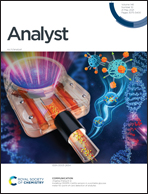Single microbead-based fluorescent aptasensor (SMFA) for direct isolation and in situ quantification of exosomes from plasma†
Abstract
Exosomes are cell-derived membrane-enclosed biological nanoparticles that carry lots of parental molecular information, and are recognized as an ideal biomarker for non-invasive diagnosis. However, due to the low abundance of exosomes in plasma samples and the interferences from complex biological matrices, the sensitive and direct detection of exosomes still remains a challenge. Here, by combining the direct magnetic isolation with in situ fluorescence imaging, we developed a Single Microbead-based Fluorescent Aptasensor (SMFA) for specific enrichment and sensitive quantification of exosomes from plasma. In the SMFA, a single aptamer-modified microbead (MB) served as the reaction carrier so that the specific exosomes inserted with a fluorescent anchor will be highly enriched on the single MB. By in situ fluorescence imaging to monitor the fluorescence signals on the single MB, sensitive detection of exosomes can be realized without the requirement of any signal amplification routes, and as low as 4.9 × 104 particles per μL of exosomes could be simply detected. More importantly, the SMFA could be applied for direct detection of the exosomes from small amounts of clinical plasma samples without prior purification procedures, indicating its great potential applications in clinical diagnostics.



 Please wait while we load your content...
Please wait while we load your content...